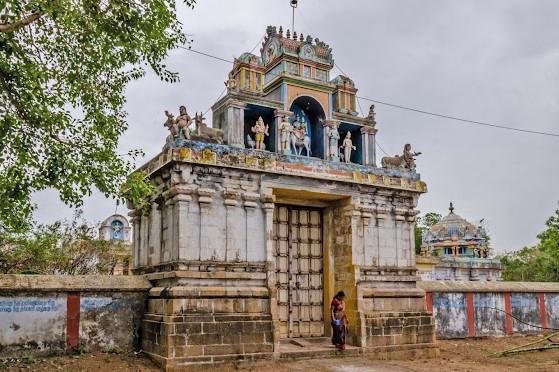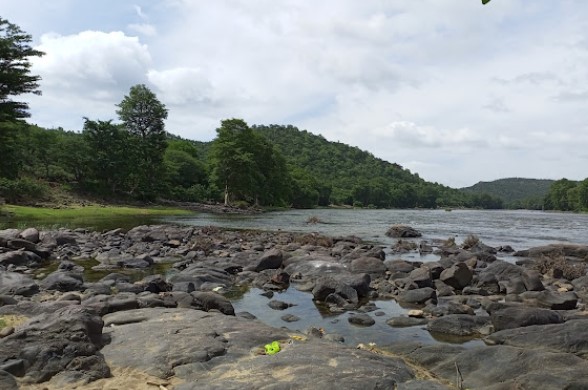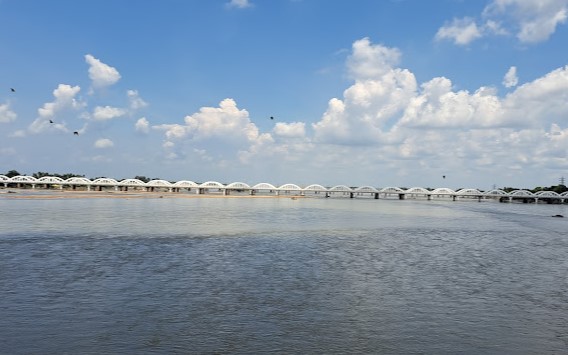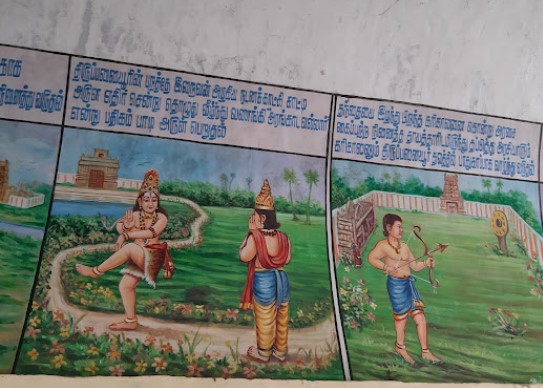
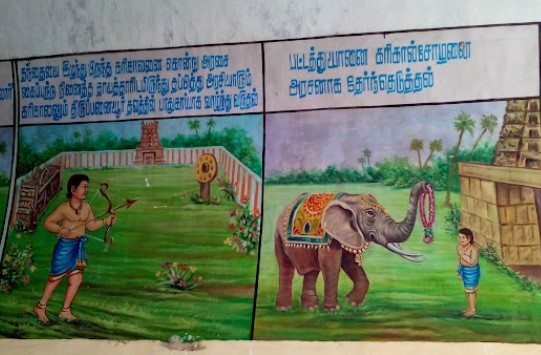
- This is the 190th Thevara Paadal Petra Shiva Sthalam and the 73rd sthalam located on the southern bank of the river Kaveri in Chozha Nadu. Known as Thalavanam, meaning "palm tree forest," the temple here is dedicated to Lord Shiva and is called Thalavaneswaram.
- As one of the 276 Devara Paadal Petra Shiva Sthalams, Thalavaneswaram is notable for housing a Swayambumurthi, or self-manifested idol, of Lord Shiva. The temple is oriented eastward and features a unique, small main tower that is not tiered.
- Instead of a traditional gopuram, the entrance showcases an exquisite sculpture of Lord Shiva and Goddess Parvati.
- The temple has two corridors but lacks a flag post, known as the Dwajasthambam. Historical significance is added by the fact that the great Chola King Karikalan spent his childhood in this area. The last consecration ceremony, or Maha Kumbabishekam, took place on August 26, 1973.
HISTORY AND CONSTRUCTION:
- The historical name of this place is Thalavanam, with the temple known as Thalavaneswaram, where “Thalam” translates to palm tree.
- Among the 276 Paadal Petra Shivasthalams, only a few temples feature the palm tree (Panai) as their Sthala Viruksham. Notable among these are Thiru Panaiyur, Thiru Vanparthan Panankattur, Thiru Puravaar Panankattur, Thiru Cheyyar, Thiru Mazhapadi, Thiru Valampuram, and Thiruppanandal.
- Historically, the great Chola King Karikalan spent around ten years of his childhood at this temple to protect himself from his enemies.
- Following the assassination of his father, King Ilamchetchenni, Karikalan and his mother were taken to the temple by his maternal uncle, Irumbidar Thalaiyar, a poet from the Sangam era, to ensure their safety.
- Karikalan's mother prayed to Lord Shiva for protection, and it is believed that Lord Vinayakar began guarding them.
- At the age of 13, with his uncle’s assistance, Karikalan fought to reclaim his kingdom.
- Legend states that when the Chola ministers dispatched a state elephant to search for the prince, the elephant found him and adorned him with a garland.
- At the temple's entrance stands an idol of Vinayakar known as “Thunai Iruntha Vinayagar,” meaning "Vinayakar who stands by as an escort."
- The temple houses approximately 14 stone inscriptions dating back to the reigns of Chola King Kulothungan I, Sundara Pandiyan, Parakirama Pandiyan, Rajathi Rajan I, and Rajarajan II. These inscriptions refer to the deity as Panaiyadiyappan and Panangattiraivan and indicate that the temple, constructed from granite, was built in the early 11th century.
- The village surrounding the temple is referred to as Rajendra Cholap Panaiyur.
PURANIC SIGNIFICANCE 1:
- The main Shivalingam at this temple is believed to have been installed and worshipped by Sage Parasarar, and the deity is honoured as “Sri Thalavaneswarar,” with “Thalam” meaning palm tree.
- Another notable legend recounts that when Saint Sundaramurthy Nayanar arrived at the entrance of this village, Lord Shiva blessed him by revealing a vision of His cosmic dance. Nearby, there is a site called “Manikka Nachiyar Thittu,” which features a tank known as “Santhitha Theertham.”
- This tank symbolises the meeting of Lord Shiva and the Nayanar, with “santhitha” meaning "met" in Tamil. In his hymn, Saint Sundaramurthy Nayanar beautifully describes the divine dance darshan he received.
- It is believed that many revered figures have worshipped at this temple, including Goddess Mahalakshmi, Sage Parasarar, the Saptha Rishis (Kausikar, Kasyabar, Bharadwajar, Gauthamar, Agasthiyar, Athiri, and Birugu), as well as Saint Thirugnanasambandar and Saint Sundaramurthy Nayanar. Additionally, notable Chola kings, including Musukunda Chakravarthy and Karikalan, are also said to have offered their prayers here.
PURANIC SIGNIFICANCE 2:
- It is believed that the Shiva Linga at this temple was installed by Sage Parashara, and Lord Shiva is revered as Sri Thalavaneswarar, with “Thala” referring to a variety of palm tree.
- Many revered figures, including Goddess Mahalakshmi, Sage Parasarar, the Sapta Rishis (Kaushikkar, Kashyapa, Bharadwaja, Gauthamar, Agasthiyar, Athiri, and Birugu), Thirugnanasambandar, Thirunavukkarasu Swamigal, Muchukunda Chakravarthy, and Karikala Chozhan, are believed to have worshipped Lord Shiva here.
- According to legend, at the request of Paravai Nachiyar, Sundarar received gold from Lord Shiva to celebrate the Panguni Uthiram festival in Thiruvarur.
- He sang the hymn “தம்மையே புகழ்ந்து” and worshipped Lord Shiva at Thirupugalur before arriving at Thirupanaiyur, where he received a divine darshan from Lord Shiva.
- Sundarar then composed hymns in praise of the deity, referring to Him as “அரங்காடவல்லார் அழகியார்.”
- This temple is also significant for its connection to the Sapta Rishis, Sage Parasarar, Mahalakshmi, and Karikala Chozhan, who are said to have lived in this area and worshipped the Lord.
- In remembrance of this divine encounter, the elevated site to the northeast of the village is known as “Santhitha Theerththam,” symbolising the meeting of Lord Shiva and his devotees.
- Karikala Chozhan was born after his father was killed by Thayathar.
- His uncle, the poet Irumbidathalayar from the Sangam period, saved both Karikalan and his mother by bringing them to this temple.
- The queen worshipped Vinayaga here, and they lived in this place for eight years.
- As Vinayagar accompanied Karikala Chozhan during this time, He is affectionately known as “Thunai Iruntha Vinayagar.”
Legends and Historical Significance
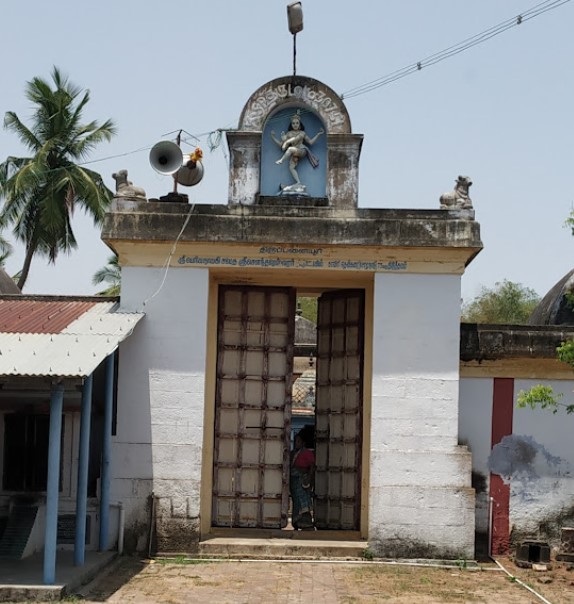
Karikala Chozhan, who lost his father to enemies, was brought to this temple by his uncle, Irumbidathalayar, to ensure their safety. The queen worshipped the Vinayaga here during their eight years of refuge, leading to the name “Thunai Iruntha Vinayagar.”
The temple also features a Vinayakar called “Madaruraitha Vinayagar,” echoing the legend of Sundarar in Thiruvarur. The main deity, Thalavaneswarar, is represented by a square Audaiyar and faces west.
ADMINISTRATION:
Currently, the temple is administered by the Hindu Religious and Charitable Endowments Department of the Government of Tamil Nadu (HR&CE).
